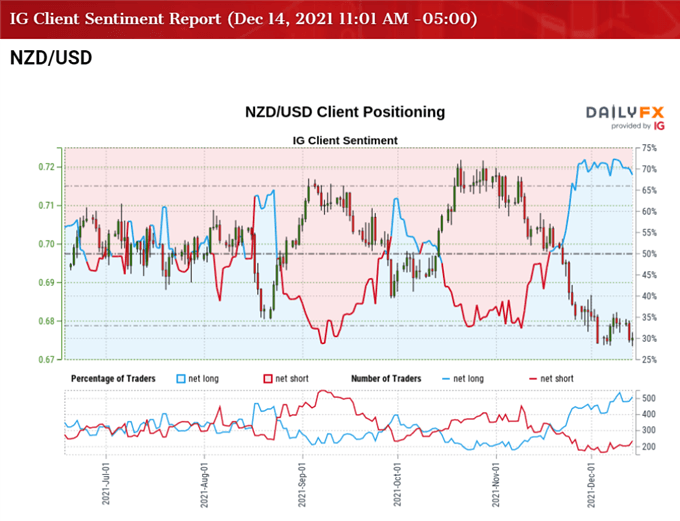New Zealand Dollar Talking Points
NZD/USD extends the decline from the start of the week to trade to a fresh yearly low (0.6735), and a move below 30 in the Relative Strength Index (RSI) is likely to be accompanied by a further decline in the exchange rate like the behavior seen earlier this month.
NZD/USD Outlook: RSI Flirts with Oversold Zone Ahead of Fed, NZ GDP
The recent rebound in NZD/USD triggered a textbook buy signal in the RSI as it pulled the oscillator out of oversold territory, but key developments coming out of the US and New Zealand are likely to influence the near-term outlook for the exchange rate as the Federal Open Market Committee (FOMC) look poised to deliver a rate hike in 2022 while New Zealand faces a slowing recovery.
It remains to be seen if the FOMC will adjust the forward guidance for monetary policy as the central bank is slated to update the Summary of Economic Projections (SEP), and the fresh forecasts from Chairman Jerome Powell and Co. may trigger a bullish reaction in the US Dollar if the officials project a steeper path for the Fed funds rate.
At the same time, more of the same from the FOMC may drag on the Greenback as market participants push out bets for a Fed rate hike, and NZD/USD may attempt to retrace the decline from earlier this week as long as the RSI holds above oversold territory.

However, New Zealand’s GDP report may keep NZD/USD under pressure as the growth rate is expected to contract 1.6% in the third quarter of 2021, and signs of a slowing recovery may push the Reserve Bank of New Zealand (RBNZ) to the sidelines as Prime Minister Jacinda Ardern considers extending travel restrictions in response to the Omicron variant.
As a result, the RBNZ may move to the sidelines after delivering back-to-back rate hikes this year, and Governor Adrian Orr and Co. may endorse a wait-and-see approach at its first meeting in 2022 as “the Committee assessed risks to their price stability and maximum sustainable employment objectives as being broadly balanced over the medium term.”
In turn, the bearish price action in NZD/USD may carry into next year as the exchange rate trades to fresh yearly lows in the second half of 2021, but a further decline in the exchange rate may fuel the tilt in retail sentiment like the behavior seen earlier this year.
The IG Client Sentiment report shows 70.47% of traders are still net-long NZD/USD, with the ratio of traders long to short standing at 2.39 to 1.
The number of traders net-long is 0.20% higher than yesterday and 7.55% higher from last week, while the number of traders net-short is 5.70% lower than yesterday and 4.88% higher from last week. The rise in net-long interest keeps the crowding behavior in play as 70.44% of traders were net-long NZD/USD last week, while the increase in net-short position comes as the exchange rate trades to a fresh yearly low (0.6735).
With that said, a hawkish forward guidance from the FOMC along with a contraction in New Zealand GDP may keep NZD/USD under pressure, and looming developments in the Relative Strength Index (RSI) may show the bearish momentum gathering pace if the oscillator slips below 30 to push into oversold territory.
NZD/USD Rate Daily Chart
Source: Trading View
- NZD/USD continues to trade to fresh 2021 lows in December after failing to defend the August low (0.6805), and a move below 30 in the Relative Strength Index (RSI) is likely to be accompanied by a further decline in the exchange rate like the behavior seen earlier this month.
- Lack of momentum to close above the 0.6810 (38.2% expansion) regionkeeps the 0.6700 (38.2% retracement) to 0.6710 (61.8% expansion) area on the radar, with a break below the 0.6640 (23.6% expansion) region opening up the November 2020 low (0.6589).
- However, the RSI may start to diverge with price as it manages to hold above 30, with a close above the 0.6810 (38.2% expansion) region bringing the 0.6870 (50% retracement) area on the radar, which lines up with the monthly high (0.6868).
- A break above the December opening range brings the Fibonacci overlap around 0.6940 (50% expansion) to 0.6990 (23.6% retracement) on the radar, with the next area of interest coming in around 0.7070 (61.8% expansion) to 0.7110 (38.2% expansions).
— Written by David Song, Currency Strategist
Follow me on Twitter at @DavidJSong




Be the first to comment